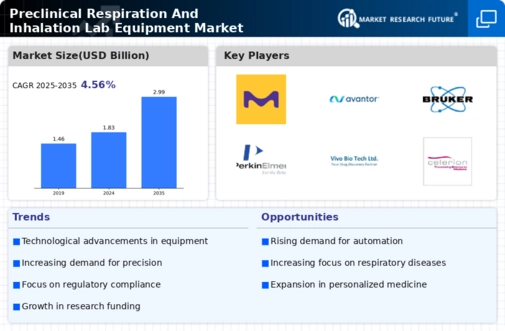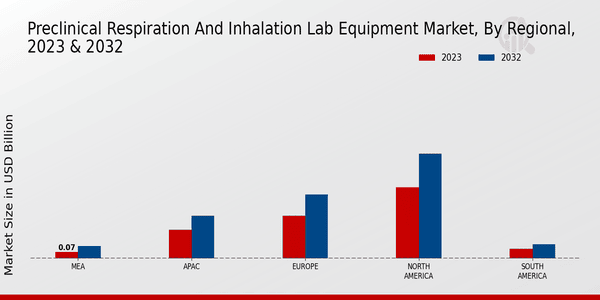Market Growth Projections
The Global Preclinical Respiration And Inhalation Lab Equipment Market Industry is projected to experience substantial growth over the coming years. With an estimated market value of 1.83 USD Billion in 2024, it is expected to reach 2.99 USD Billion by 2035, reflecting a compound annual growth rate (CAGR) of 4.57% from 2025 to 2035. This growth trajectory indicates a robust demand for innovative lab equipment, driven by factors such as increased funding for biomedical research, technological advancements, and a growing focus on personalized medicine. The market's expansion is indicative of the critical role that preclinical research plays in advancing respiratory health.
Growing Focus on Personalized Medicine
The shift towards personalized medicine significantly influences the Global Preclinical Respiration And Inhalation Lab Equipment Market Industry. Researchers are increasingly tailoring therapies to individual patient profiles, necessitating advanced inhalation and respiration technologies that can accommodate diverse biological responses. This trend is fostering the development of specialized preclinical models that accurately simulate human respiratory conditions. As personalized medicine gains traction, the demand for innovative lab equipment is expected to rise, contributing to the market's growth trajectory. The emphasis on individualized treatment strategies may lead to a more nuanced understanding of respiratory diseases, ultimately benefiting patient outcomes.
Increased Funding for Biomedical Research
The Global Preclinical Respiration And Inhalation Lab Equipment Market Industry benefits from increased funding directed towards biomedical research. Governments and private organizations are recognizing the importance of respiratory health, leading to substantial investments in preclinical studies. This influx of funding enables research institutions to acquire state-of-the-art inhalation and respiration equipment, thereby enhancing their research capabilities. As a result, the market is poised for growth, with a compound annual growth rate (CAGR) of 4.57% projected from 2025 to 2035. This financial support is crucial for driving innovation and advancing the understanding of respiratory diseases.
Regulatory Compliance and Quality Standards
Regulatory compliance and adherence to quality standards are critical drivers of the Global Preclinical Respiration And Inhalation Lab Equipment Market Industry. As regulatory bodies impose stringent guidelines on preclinical research, laboratories must invest in high-quality inhalation and respiration equipment to ensure compliance. This necessity compels research institutions to prioritize the acquisition of reliable and validated technologies, which can withstand rigorous scrutiny. Consequently, the market is likely to experience growth as laboratories seek to meet these evolving standards. The emphasis on quality assurance not only enhances research integrity but also fosters trust in the results generated from preclinical studies.
Technological Advancements in Lab Equipment
Technological innovation plays a pivotal role in shaping the Global Preclinical Respiration And Inhalation Lab Equipment Market Industry. The introduction of sophisticated devices, such as high-precision inhalation systems and automated data collection tools, enhances the accuracy and efficiency of preclinical studies. These advancements not only streamline research processes but also improve the reproducibility of results, which is crucial for regulatory compliance. As researchers increasingly adopt these cutting-edge technologies, the market is expected to grow, with projections indicating a rise to 2.99 USD Billion by 2035. This growth underscores the importance of continual investment in technology to meet evolving research needs.
Rising Demand for Respiratory Disease Research
The Global Preclinical Respiration And Inhalation Lab Equipment Market Industry experiences heightened demand driven by the increasing prevalence of respiratory diseases. As global health organizations report a rise in conditions such as asthma and chronic obstructive pulmonary disease, research institutions are compelled to invest in advanced inhalation and respiration equipment. This trend is reflected in the market's projected growth, with an estimated value of 1.83 USD Billion in 2024, indicating a robust need for innovative solutions in preclinical settings. The focus on respiratory disease research is likely to propel the industry forward, fostering advancements in therapeutic approaches and inhalation technologies.






















Leave a Comment